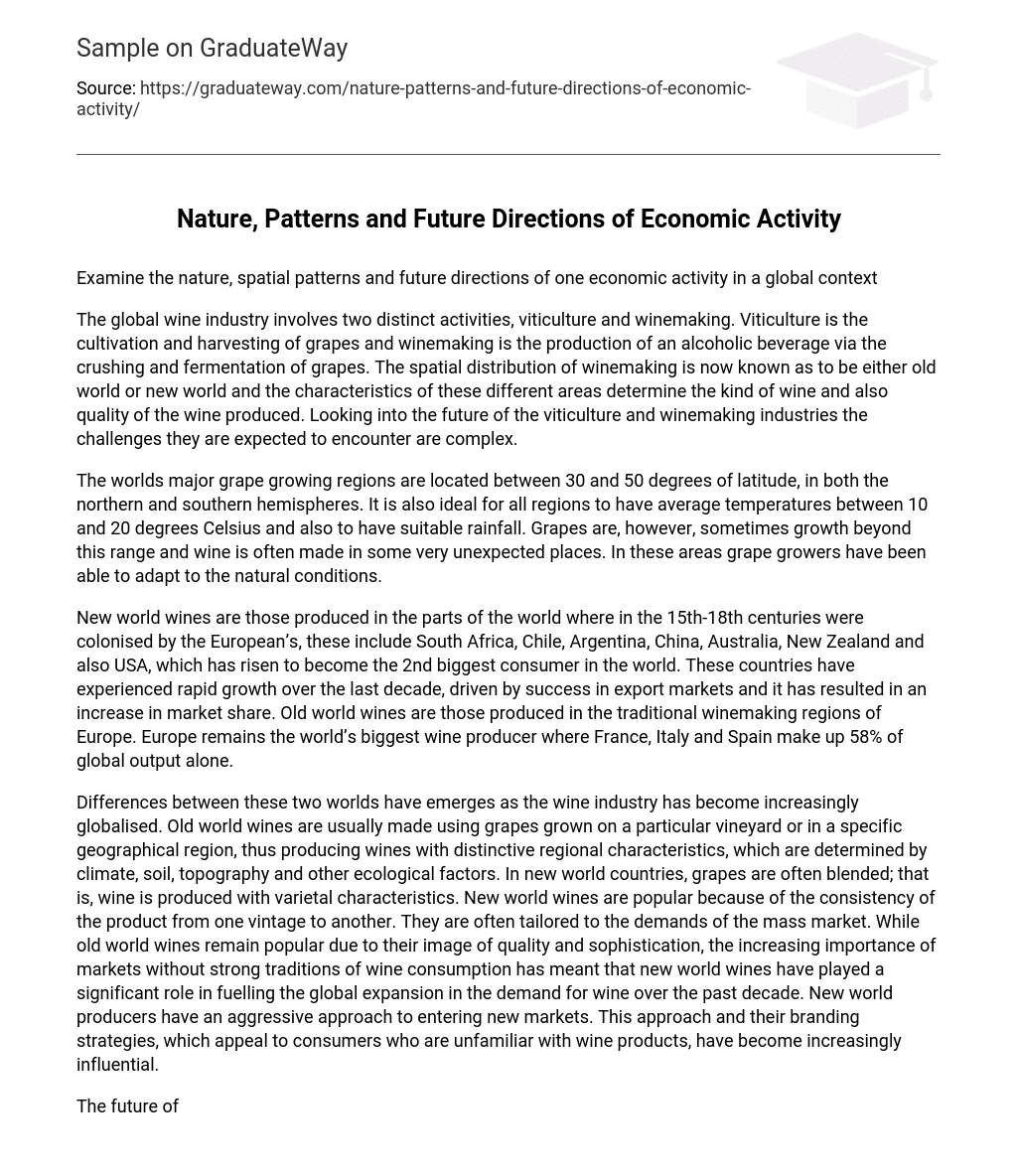Examine the nature, spatial patterns and future directions of one economic activity in a global context
The global wine industry involves two distinct activities, viticulture and winemaking. Viticulture is the cultivation and harvesting of grapes and winemaking is the production of an alcoholic beverage via the crushing and fermentation of grapes. The spatial distribution of winemaking is now known as to be either old world or new world and the characteristics of these different areas determine the kind of wine and also quality of the wine produced. Looking into the future of the viticulture and winemaking industries the challenges they are expected to encounter are complex.
The worlds major grape growing regions are located between 30 and 50 degrees of latitude, in both the northern and southern hemispheres. It is also ideal for all regions to have average temperatures between 10 and 20 degrees Celsius and also to have suitable rainfall. Grapes are, however, sometimes growth beyond this range and wine is often made in some very unexpected places. In these areas grape growers have been able to adapt to the natural conditions.
New world wines are those produced in the parts of the world where in the 15th-18th centuries were colonised by the European’s, these include South Africa, Chile, Argentina, China, Australia, New Zealand and also USA, which has risen to become the 2nd biggest consumer in the world. These countries have experienced rapid growth over the last decade, driven by success in export markets and it has resulted in an increase in market share. Old world wines are those produced in the traditional winemaking regions of Europe. Europe remains the world’s biggest wine producer where France, Italy and Spain make up 58% of global output alone.
Differences between these two worlds have emerges as the wine industry has become increasingly globalised. Old world wines are usually made using grapes grown on a particular vineyard or in a specific geographical region, thus producing wines with distinctive regional characteristics, which are determined by climate, soil, topography and other ecological factors. In new world countries, grapes are often blended; that is, wine is produced with varietal characteristics. New world wines are popular because of the consistency of the product from one vintage to another. They are often tailored to the demands of the mass market. While old world wines remain popular due to their image of quality and sophistication, the increasing importance of markets without strong traditions of wine consumption has meant that new world wines have played a significant role in fuelling the global expansion in the demand for wine over the past decade. New world producers have an aggressive approach to entering new markets. This approach and their branding strategies, which appeal to consumers who are unfamiliar with wine products, have become increasingly influential.
The future of winemaking looks to face many challenges globally consisting of the production and consumption aspect, especially with the old and new world wines. There have been recent changes in spatial patterns of production and consumption of wine globally. In the traditional wine making regions of Europe the consumption of wine has declined due to a combination of factors such as younger generations turning to spirits and cheaper forms of alcohol. Another factor and example is Islamic people coming to these regions that don’t drink wine or even alcohol and therefore limit the consumption of these areas. There are new and emerging markets in Asia, especially China who are now a large producer and therefore consumer of wine, with production now exceeding Australia’s. In the 1980s China produced 30,000 bottles of wine a year and by the end of 2010 they were producing 6 million annually. This is attributed to improved living standards, which has lead to an increase in demand and opened up a massive market.
Tensions between traditional winemaking techniques and the new ‘industrial’ production process can put pressure on the old world producers in ways such as amount of produce made because of the advanced technology the new world producers use which seems more consistent then the traditional way. There are large ecological sustainability concerns and that the environment these vineyards are placed in can be harmed from various machinery. The soil the vines are planted in can be destroyed and can affect future planting and therefore production.
The viticulture and wine making industry are extremely large globally and are expanding everyday becoming more and more popular in new areas. Viticulture is the cultivation and harvesting of grapes and winemaking is the production of an alcoholic beverage via the crushing and fermentation of grapes. Both the new world and old world wines are important and show variation in the traditional ways originally in Europe and the newly technological aspect of the industry. The nature of wine making contains many parts including the wine making process, wine characteristics and spatial distribution. The future of viticulture and wine making is seen to have a few serious challenges to confront and need to have solutions mainly to do with wine consumption.





